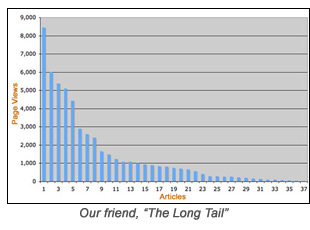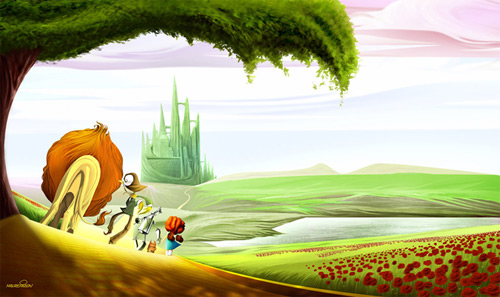
"It’s really scary out there." That’s a phrase I keep hearing again and again.
When I consider the challenges facing editors & content creators, among them is the fact that they have precious few resources to do a massive amount of work. On top of that, there is a constant barrage of reports of their demise, which is never pleasant.
So, the question I have isn’t: "How do we do more with less," but rather:
How do we do exactly the right things – and only those right things – really really well?
I have been exploring this issue recently with some posts on editorial ROI:
And want to continue that exploration today, considering lessons from three children’s movies along the way.
The Illusion of "Value"
Everything is valuable, to someone, somewhere. The tough part is decising which efforts have ENOUGH value to really shape your industry. Where is the line between "some" value and "incredible" value – the line between a nice product, and a must-have product?
In B2B media, that can be defined in a number of ways, but here is one I like: you need to provide something that enables business and careers within the market you serve.
A definition like this goes beyond just "informing" or "adding context," becoming an essential piece of the process.
 This week, I have continued online editorial analysis of some brands within RBI, digging into web analytics and segmenting data to make it more meaningful. When you do something like this, you find typical long tail graphs when looking at performance of content over a particular time frame.
This week, I have continued online editorial analysis of some brands within RBI, digging into web analytics and segmenting data to make it more meaningful. When you do something like this, you find typical long tail graphs when looking at performance of content over a particular time frame.
Take a look at the long tail chart to the right. It measures article performance for 37 articles over the course of one month. Now, the articles in the middle and to the right took a fair amount of effort to create, and have SOME value to their market. The question is:
How much value is enough to justify the effort?
For an editorial team of 5 staff members covering their market in print, online and at events, this is a critical question.
When the members of that team are still at their desk at 7pm and wondering how they can get to everything on their plate – it is this graph and this question that can help answer it. If they aren’t measuring what is worthwhile and what isn’t, then their workday keeps getting longer and longer.
And this is what discerns "good" products from "great" products. Making those hard choices.
I was recently considering this same concept after watching the movie version of Where the Wild Things Are. This is a movie that made some very clear and very controversial choices in terms of style, characters, plot and production. And at every step of the way, the director Spike Jonze had to battle his way forward with the studio, who would have preferred more obvious choices – something more akin to Shrek.
People’s opinions on the resulting film will vary. Personally, I found it to be a nuanced worked of art that deals more honestly with the conflicting desires, hopes, emotions and realities of both adults and children. Here are three great articles on the film from the NY Times:
- A Long Profile of the Director and Creation of the Movie
- Movie Review
- Further Reflections on the Film
All in all… Spike Jonze decided that the "value" of his film would be measured by something greater than box office earnings… by how deeply it served his audience. For him, it had to transcend normal expectations and become something more complex… a work of art. And this is where I find relation to B2B media and the markets they serve, which are about more than just scale (selling a lot of a particular media product) – they are focused on the depth at which you are shaping these tiny niches filled with experts – people who are looking for solutions to complicated problems.
And this is what discerns a "good" product, from a "great" product. It should be noted that the movie seems to be doing well at the box office.
Don’t Fade Away.
My weekly obsession this week was watching the Wizard of Oz again, and then researching its history, meaning and legacy. And like all things, I couldn’t help but find a metaphor for publishing.
Roger Ebert describes the film:
"The ending has always seemed poignant to me. Dorothy is back in Kansas, but the color has drained from the film, and her magical friends are mundane once again"
This may be so, but at the end of the film, she is left with two additional things:
- An appreciation for just how special the people around her are, and for this place called home.
- An understanding that she alone must create her adventure in life, to make decisions, to stand up, to be, and to create. Friends will help along the way, but it is for her to start the journey.
Much like the modern publishing & media company, like journalists, like those trying to navigate the waters of the digital world, there is a fight to remain relevant, to remain profitable, and to fill their hopes and desires for a bright and exciting future. Dorothy’s struggle is not just to go home, but to find her own voice… to make the transition from the child that no one has time for, to the adult who will be the compass for her own life.
For those of us in publishing and media today, we find ourselves having crash landed in MunchkinLand.
A strange world, with strange rules and incredible danger. And this is why – especially in B2B media – there is such a need for AMAZING products. Products that enable industries, that push careers forward, products that simply put a smile on people’s faces.
The danger is not in being scooped up by flying monkey – the danger is irrelevance. The danger is in changing too slowly as new competitors eat up marketshare or push forward with a new service that required a risk that few were willing to take.
To fight this danger, it takes a single and simple step to engage it… to go down that yellow brick road.
And this is not just a cutesy metaphor, it is a measure of will. Consider this:
"In the past 10 years alone [Steve Jobs] has radically and lucratively reordered three markets — music, movies, and mobile telephones — and his impact on his original industry, computing, has only grown."
Getting Past Barriers.
Now, if I had to identify the biggest barrier to positive change for those in media, it wouldn’t be technology, and it wouldn’t even be attitude. It would be cognitive dissonance. The fact that people are running on their treadmills so quickly, juggling so many tasks while doing so, and singing a song filled with passion at the same time, that they can’t step back to strip everything away to consider strategy fresh and new. The problem isn’t recognizing that there are barriers, but in accepting that they themselves are the barrier.
How do we find room for improvement? We stop, and we do some of the following:
- Measure Performance
Two weeks ago I gave some basic examples using long tail graphs. For truly insightful ways of understanding how your business is performing online, go to the master, Avinash Kaushik, and his new book Web Analytics 2.0. My copy just arrived in the mail, so it should be a fun weekend ahead! - Have Goals
Simply reporting the news is not a goal. Do you know specifically how your brand affects the business and careers of your market? If you can’t answer that question, then you may need to rethink your value in a world where information is cheap, but solutions are rare. - Test
This can be as simple as A/B testing an article headline or as advanced as testing a new layout or product performance before launching. Also… don’t be afraid to test products that you have been producing for years, you might be amazed to find incredible value in small improvements. - Focus
Don’t be afraid to stop doing certain things. If all of your products aren’t amazing or don’t serve an incredibly essential need in your market, then they are likely expendable.
If an element of your brand isn’t amazing,
then it is simply watering down your product offering
and wasting your resources.You can approach this in large ways or small ways. Often, when analyzing a blog strategy for a brand, I won’t hesitate to advise that they kill a blog or two. Doing so ensures that their other blogs gets more resources, and readers aren’t overwhelmed by an unfocused strategy.
- Focus on Unique Value
Identify overlaps in your product offering to that of your competition. If they are covering the same news you are in the same way, then you can expect problems in garnering attention and wooing advertisers. And being mildly unique is not enough to find the kind of growth that you need… look for exceptional ideas that eclipse your competition. - Benchmark
Look around and give an honest assessment of your performance compared to that of your competition. Be wary of relying on survey data that says your audience prefers you over your competitor by 90%. That data is likely not nuanced enough to shape the future of your brand.Consider this even in small ways, such as measuring your social media strategy. Don’t be satisified with 1,000 followers on Twitter, be satisfied when you have 500% more followers than you nearest competitor, are listed 10 times more han they are, and you have way more @replies and coversation.
- Come Together
Bring IT developers, web business managers, sales teams, editorial teams and others together more often to improve and create products as a group. Each segment of your staff has incredible insights that need to be shared. If you aren’t chatting with folks outside of your immediate group, then you are missing connections that are right under your nose. - Research
Of course, the real answers to the future of your business lies with your customers. All you need to do is observe and ask. Don’t go on assumptions, or settle on expected answers to easy questions. Dig. Ask the difficult questions again and again.
We can’t let assumptions be confused with evaluation – that because we believe something should do well, that that was in fact what happened. We need a sober and honest look at how things actually performed, why, and how we can improve the next time around.
A key question to ask your editorial team:
How can you and your products become a part of the business process for your industry?
Print is still a core way B2B media can serve their audience, but to find a future that is full of growth, one needs to find the opportunity gaps – the places where you can add value at critical stages of the business cycle.
This may have little to do with news. It might have little to do with articles. And that’s okay.
It’s hard turning a ship when the weather is violent and the compass broken. But in the end, this quote from The Goonies applies to all of us in publishing and media:
"This is our time."



Cartoon cats to consider are Tom, Sylvester or Garfield. Disney and Dreamworks films offer a plethora of character names…Ariel, Bambi, Aladdin, Shrek, Mulan, Woody, Buzz.